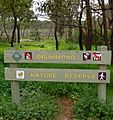Drummond Nature Reserve facts for kids

The Drummond Nature Reserve is a special nature reserve located about 10 kilometers west of Bolgart, Western Australia. It's named after a famous plant scientist, James Drummond. This reserve is home to many different plants – about 439 kinds! Some of these plants are very rare and important to protect.
History
In 1993, the land was bought by a government group that looks after nature. They made it an "A class" reserve, which means it's very important to protect. Before it became a reserve, the land was used for grazing animals. Even with this use, the land was in great shape.
The reserve is named after James Drummond, a plant expert who lived nearby in Toodyay. He explored this area and collected plants here between 1841 and 1844.
Landscape and Plants
The Drummond Nature Reserve has rolling hills made of a special type of rock called laterite. Scientists have found ten different types of plant areas here. These areas depend on the soil, the shape of the land, and how water drains.
You can find six different types of woodlands in the reserve. There are also two types of "granite heath" areas. One of these heath areas has plants like Xanthorrhoea preissii and Gastrolobium calycinum. The other has lots of Melaleuca and Dodonaea plants.
There's also a "mallee" plant area. Here, the main plants are low, dense Eucalyptus drummondii and Allocasuarina.
In the northwest corner, there's a Wandoo Woodland. Sadly, many trees here are dying because of too much salt in the soil. Weeds have also started to grow where other plants used to be.
Amazing Plants
From 1999 to 2000, experts walked through the reserve to find all the plant species. They found 439 different kinds of vascular plants. Most of these (405) are native to the area, but 35 are alien species.
Two plants found here are considered very rare:
- The water plant Trithuria leptogyne: This is the only known place in the world where this plant grows!
- Eleocharis keigheryi: This plant was found in two different spots.
There are also seven other "priority species" in the reserve. These plants are important to watch and protect:
| species | priority |
|---|---|
| Acacia chapmanii subsp. australis | rare |
| Comesperma rhadinocarpum | two |
| Tricoryne arenicola | two |
| Platysace ramosissima | three |
| Stenanthemum tridentatum | three |
| Hydrocotyle lemnoides | four |
| Schoenus natans | four |
Other interesting plants in the reserve include:
- Cyathochaeta equitans: This plant is usually found near the coast, but here it is far inland!
- A special mix of Eucalyptus loxophleba trees.
- Schoenus aff. loliaceus: This might be a brand new species of Schoenus plant.
- Rhodanthe pyrethrum: This plant is at its most northern point of growth here.
Photo gallery









